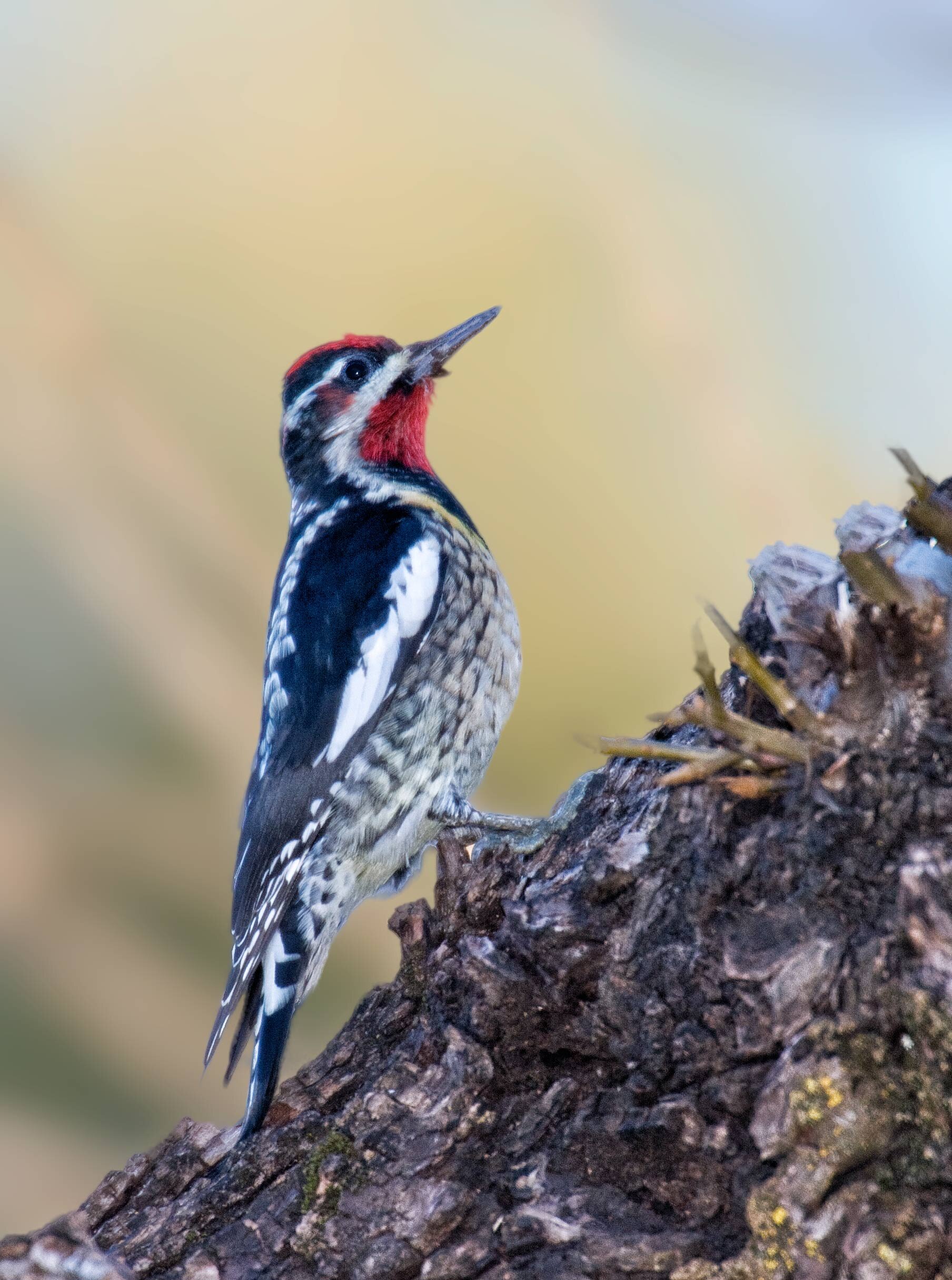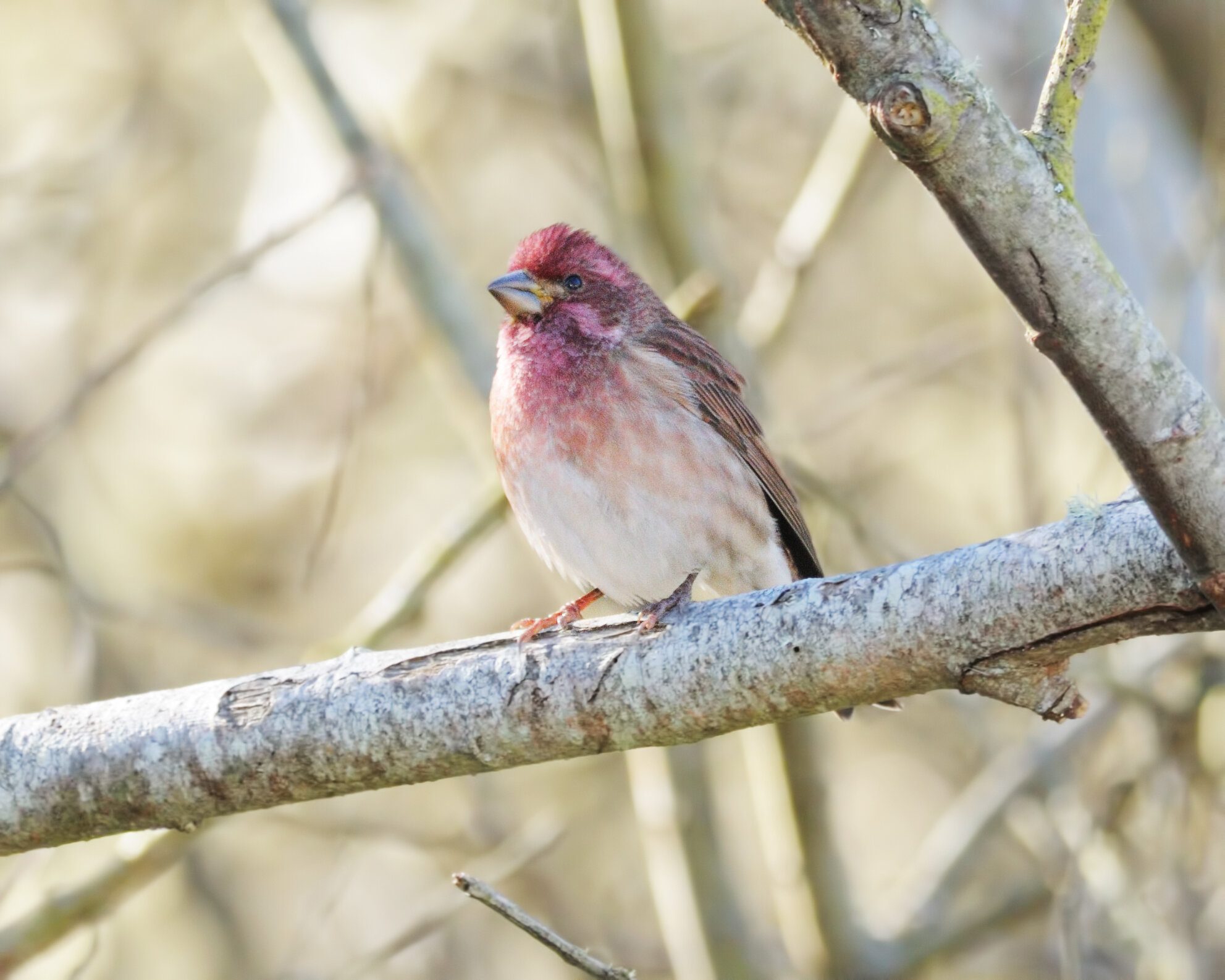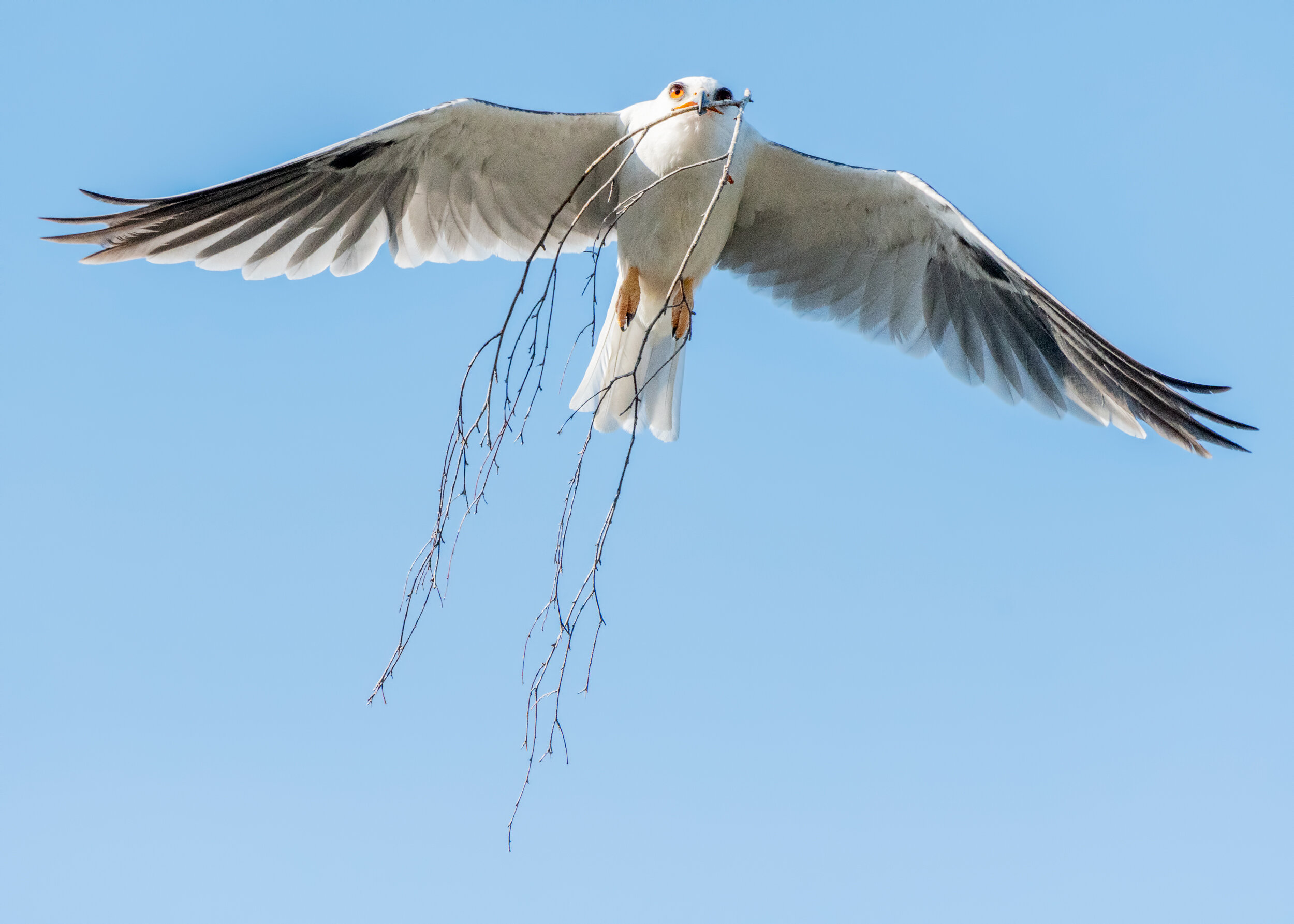This tour of urban parks begins in William Land Park and continues south. From Interstate 5, exit at Sutterville Road and turn left. After crossing the overpass, go right at the sign for Riverside Boulevard which then circles around to head north to William Land Park. From William Land Park continue the tour south to the other urban parks.
William Land Park
Although most of the area south of William Land Park has been taken over as a residential area, the birding is surprisingly good in the few remaining natural spots. Probably the best is the “panhandle” along Riverside Boulevard between 11th and 13th Avenues.
Red-naped Sapsucker, Image by Ray Rozema
Birding the site: Large conifers, and berry-laden shrubs and trees attract winter flocks of American Robin, Cedar Waxwing, Yellow-rumped Warbler, Dark-eyed Junco, and American Goldfinch. Red-breasted Sapsucker is usually present and Red-naped and Yellow-bellied Sapsuckers have been seen in the area. Hutton’s Vireo can usually be found in the evergreen oaks. This is as good a place as any in Sacramento to look for wintering Varied Thrush (under the redwoods), Red-breasted Nuthatch, Golden-crowned Kinglet, Townsend’s Warbler, Purple Finch and Pine Siskin. eBird Sightings
Directions to William Land Park: From downtown Sacramento, take Interstate 5 for 2.0 miles south of Highway 50 and exit at Sutterville Road and turn left. After crossing the overpass, go right at the sign for Riverside Boulevard which then circles around to head north to William Land Park.
From the William Land Park, proceed south on Riverside Boulevard to the next location on the tour, Reichmuth Park. Turn left at 43rd Avenue to Gloria Drive and turn right. Parking is available in the park and along Gloria Drive. The nature trail begins east of the Sump 55 building to the south of the parking lot.
Reichmuth Park
Purple Finch, Image by Daniel Lee Brown
Reichmuth Park, formerly an oxbow lake, is now playing fields and a swampy, wooded nature area. The low-lying soccer fields revert to a lake in rainy winters, attracting California, Ring-billed and Short-billed Gulls. When dry, they attract American Crow, Blackbirds, American Pipit and American Robin. In recent years, the City of Sacramento approved an agreement with a Frisbee golf club to open the park to this activity. Large areas of previously dense habitat have been removed opening up the trails to allow for Frisbee golf. Consider visiting during the week as weekends can be very busy.
Birding the site: The nature area, for its size, is one of the great magnets for migrating landbirds in the Sacramento area. Sixteen warbler species have been recorded here, including all of the West Coast species plus Black-and-white Warbler, Northern Parula, American Redstart, Hooded Warbler, and Canada Warbler. Warbling Vireo, Western Tanager, Pacific-Slope Flycatcher, and Willow Flycatcher are common migrants and Olive-sided, Hammond’s, and Dusky flycatchers are also regular migrants. Hutton’s and Cassin’s vireos migrate through and occasionally overwinter. Hooded Oriole nesting in the fan palms in nearby yards bring their families to the park in August and September. Swainson’s Thrush skulk through the thickets in May. Lazuli Bunting feed in the tall grasses in August and September. Hummingbirds are ever present: Anna’s year-round; Black-chinned in spring and summer. Watch for their nests low in the blackberries. Rufous/Allen’s types migrate from July through September. Winter visitors include Wood Duck, Cooper’s and Sharp-shinned hawks, thrushes, Ruby-crowned Kinglet, Orange-crowned Warbler, many sparrows, and Purple Finch. Resident birds are: Red-shouldered Hawk, Downy and Nuttall’s Woodpeckers, Bewick’s and Northern House Wrens, Northern Mockingbird, Spotted Towhee, and House Finch. Careful scrutiny of the park’s birdlife at almost any season is bound to reveal something interesting. Close to this location, from March through the summer, Northern Rough-winged Swallow nest in drain holes where Riverside Boulevard, Seamas, 35th and 43rd Avenues pass under Interstate 5. eBird Sightings
Directions to Reichmuth Park: From the William Land Park, proceed south on Riverside Boulevard. Turn left at 43rd Avenue to Gloria Drive and turn right. Parking is available in the park and along Gloria Drive. The nature trail begins east of the Sump 55 building to the south of the parking lot.
From Reichmuth Park proceed to the next location on the tour, Greenhaven Lake. Take Shoreside Drive south (0.7 mile west of I-5), and turn left on Lake Vista Court. There are 3 parcels on this street where you can look through hog-wire fencing to view the lake.
Greenhaven Lake
Ring-necked Duck, Image by Chris Conard
Public access has been diminished to the point where it's no longer a great birding destination, but worth a check if you're in the area. In fall and winter, large flocks of Common Merganser (a Red-breasted Merganser may occasionally be found), Ruddy Duck, Gulls (mostly California and Ring-billed, but occasionally Short-billed, American Herring, and Iceland) plus occasional Western and Clark’s Grebes, Ring-necked Duck, Lesser Scaup, Canvasback, Bufflehead, Common Goldeneye and other water birds may be found. Green Heron and Belted Kingfisher forage along the shoreline, and Caspian Tern visits in the spring and summer. eBird Sightings
Directions to Greenhaven Lake: Take Shoreside Drive south from Riverside Boulevard (0.7 mile west of I-5), and turn left on Lake Vista Court. There are 3 parcels on this street where you can look through hog-wire fencing to view the lake.
From Greenhaven Lake proceed to the next location on the tour, Garcia Bend Park. Continue south on Riverside Boulevard, which turns into Pocket Road. Garcia Bend Park will be on your right opposite Windbridge Drive. To go directly to Garcia Bend, exit Interstate 5 at Pocket Road (6.0 miles south of Highway 50) and head west for 1.9 miles; the park will be on your left. For Marriott Park, from Pocket Road just west of Interstate 5, go south on Greenhaven Road for 0.2 mi, then turn left and drive 0.2 mi east on Grand River Drive to the park.
Garcia Bend Park and Marriott Park
Caspian Tern, Image by Ray Rozema
Garcia Bend Park is worth a visit in spring and fall to look for migrating landbirds in the riparian growth and Caspian or Forster’s Terns over the river. In winter, check for waterbirds you may have missed at Greenhaven Lake (described above) or River Lake (access via West Shore and East Shore drives north of Pocket Road). Marriott Park has large valley oaks that attract migrating warblers, vireos, tanagers and others in spring. eBird Sightings - Garcia Bend Park, Marriott Park
Directions to Garcia Bend Park: From the Greenhaven Lake, continue south on Riverside Boulevard, which turns into Pocket Road. Garcia Bend Park will be on your right opposite Windbridge Drive. To go directly to Garcia Bend, exit Interstate 5 at Pocket Road (6.0 miles south of Highway 50) and head west for 1.9 miles; the park will be on your left. For Marriott Park, from Pocket Road just west of Interstate 5, go south on Greenhaven Road for 0.2 mi, then turn left and drive 0.2 mi east on Grand River Drive to the park.
From Garcia Bend Park proceed to the next location on the tour, Chorley Park. From the intersection of Interstate 5 and Pocket Rd to the west and Meadowview Road to the east, drive 0.25 mi east on Meadowview Rd. Turn left and head north on Freeport Boulevard to Florin Road. Turn right and go east on Florin Rd to 20th Street. Turn left and drive north 1 block to the park. Walk west from the parking lot, behind the playing field and elementary school, to an area of weeds, willows and cottonwoods. Returning to Freeport Boulevard, continue north, back into southern Sacramento. You will pass Sacramento Executive Airport, which has a long history of harboring Burrowing Owl, though they have been much reduced and more sporadic in recent years. These birds may occasionally be seen along the drainage ditch between Freeport Boulevard and the airport, especially in the first few hours after sunrise and again a few hours before dark.
Chorley Park
White-Tailed Kites have nested in Chorley Park, Image by Daniel Lee Brown
Chorley Park is a small city park that harbors migrating land birds and nesting White-tailed Kite in spring. This area consists of weeds, willows, and cottonwood trees. eBird Sightings
Directions to Chorley Park: From the intersection of Interstate 5 and Pocket Rd to the west and Meadowview Road to the east, drive 0.25 mi east on Meadowview Rd. Turn left and head north on Freeport Boulevard to Florin Road. Turn right and go east on Florin Rd to 20th Street. Turn left and drive north 1 block to the park. Walk west from the parking lot, behind the playing field and elementary school, to an area of weeds, willows and cottonwoods. Returning to Freeport Boulevard, continue north, back into southern Sacramento. You will pass Sacramento Executive Airport, which has a long history of harboring Burrowing Owls, though they have been much reduced and more sporadic in recent years. These birds may occasionally be seen along the drainage ditch between Freeport Boulevard and the airport, especially in the first few hours after sunrise and again a few hours before dark.
Tim Manolis






